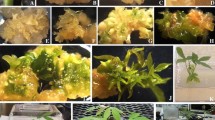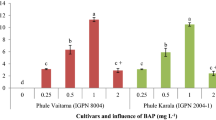Abstract
The present study aimed to determine the optimal concentration of growth regulators for regenerating Abelmoschus species through epicotyl and embryo culture. Five popular okra genotypes (four varieties, one inbred), two wild species and interspecific hybrids from crossing var. Pusa Sawani with wild relatives were used to develop in vitro regeneration protocol. SSR primers confirmed the hybridity of interspecific crosses. A total of 64 different combinations of indole-3-butyric acid (IBA), naphthalene acetic acid (NAA) and kinetin, referred to as MSOM1 to MSOM64 were used to test regeneration efficiency. Among these combinations, MS medium supplemented with NAA and IBA each with concentration of 0.5-1 mg/L and kinetin @ 1- 1.5 mg/L proved to be effective for regeneration using epicotyl and embryo explants in cultivated okra genotypes, wild species and interspecific hybrids. Regeneration efficiency in cultivated genotypes through epicotyl culture ranged from 40 to 65%. However, for both cultivated genotypes and wild species regeneration efficiency ranged from 25 to 65% by embryo culture. On an average, interspecific hybrids achieved regeneration efficiency of 35% to 75% through embryo culture. The present study indicated that the success of apical shoot culture and embryo culture in okra is influenced by the genotype, type of growth hormones and their concentrations.
Key message
In this paper we have optimized regeneration protocol using epicotyl and embryo explants in Abelmoschus spp. for advancement of pre-breeding materials as well as utilization in genetic engineering and genome editing.







Similar content being viewed by others
Data availability
All relevant data are within the manuscript and the supplemental materials.
Abbreviations
- IBA:
-
Indole-3-butyric acid
- NAA:
-
Naphthalene acetic acid
- MSOM:
-
MS okra medium
References
Acogo Y, Aidam A, Odah K, Quashie AM (1996) In vitro micropropagation of two species of okra: Abelmoschus esculentus and Abelmoschus cannabinus. Cah Agrics 5(2):109–111
Anbukkarasi V, Sadasakthi A (2017) Effect of leguminous green leaf manures and leaf extract on growth, yield, quality and economics of bhendi [Abelmoschus esculentus (L.) Moench] cv. Arka Anamika. Indian J Agric Res 51(1):9–16
Anisuzzaman M, Jarin S, Naher K, Akhtar M, Alam M, Khalekuzzaman M, Alam I, Alam M (2008a) Callus induced organogenesis in okra [Abelmoschus esculents (L.) Moench.]. Asian J Plant Sci 7(7):677–681
Anisuzzaman M, Kabir AH, Sarker KK, Jarin S, Alam MF (2008b) Micropropagation of [Abelmoschus esculentus (L.) Moench.] for disease free plantlets through meristem culture. Arch Phytopathol Plant Prot 43(5):460–466
Badiger M, Yadav RK, Sharma BB, Bhat KV, Tomar BS, Lata S, Vinay ND, Das A (2023) Pollen germination, pollen- pistil interaction and crossability studies in interspecific and induced colchiploid population of Abelmoschus species. Genet Resour Crop Evol 1–21. https://doi.org/10.1007/s10722-023-01610-y
Bajaj YPS (1998) Biotechnology in Agriculture and Forestry (cotton). Springer, Berlin, pp. 42. https://doi.org/10.1007/978-3-642-80373-4_1
Banu AN (1998) In vitro culture and plant regeneration of Chrysanthemum morifolium. M.Sc. Thesis, Plant Breeding Lab., Department of Botany, Rajshahi University, Bangladesh
Beck MJ, Caponetti JD (1983) The effects of kinetin and naphthalene acetic acid on in vitro shoot multiplication and rooting in the fish tail fern. Am J Bot 70:1–7. https://doi.org/10.1002/j.1537-2197.1983.tb12425
Chauhan DVS (1972) Vegetable production in India. 3rd ed. Ram Prasad and Sons, Agra, pp89
DAFW [Department of Agriculture and Farmers Welfare] (2022) Annual Report 2021–2022. Department of Agriculture and Farmers Welfare, Krishi Bhawan, New Delhi, 307p.
Das UR, Sayed H, Sarker RH (2001) Somatic embryogenetics and regeneration of plants from immature embryos of maize (Zea mays L.). Plant Tissue Cult 11(1):65–75
Daniel MA, David RHA, Caesar SA, Ramakrishnan M, Duraipandiyan V, Ignacimuthu S, Al-Dhabi NA (2018) Effect of l-glutamine and casein hydrolysate in the development of somatic embryos from cotyledonary leaf explants in okra [Abelmoschus esculentus (L.) moench]. S Afr J Bot 114:223–231
Dhande GA, Patil VM, Raut RV, Rajput JC, Ingle AG (2012) Regeneration of okra (Abelmochus esculentus L.) via apical shoot culture system. Afr J Biotechnol 11(86):15226–15230. https://doi.org/10.5897/AJB12.907
Ebrahimi E, Habashi AA, Ghareyazie B, Ghannadha M, Mohammadi MA (2006) Rapid and efficient method for regeneration of plantlets from embryo explants of Cumin (Cuminum cyminum L.). In Vitro Cell Dev Biol Plant 42(5):455–460. https://doi.org/10.1023/A:1024676507010
Evans DA, Sharp WR, Bravo JE (1984) Cell culture methods for crop improvement. In: Sharp WR, Evans DA, Ammirato PV, Yamada Y (eds) Hand book of plant cell culture. Macmillan Publishing Company, New York, p 2
Ganesan M, Chandrasekar R, Kumari BR, Jayabalan N (2007) Somatic embryogenesis and plant regeneration of Abelmoschus esculentus through suspension culture. Biol Plant 51(3):414–420
Gemede HF, Ratta N, Haki GD, Woldegiorgis AZ, Beyene F (2015) Nutritional quality and health benefits of okra (Abelmoschus esculentus): a review. J Food Process Technol 6(458):2. https://doi.org/10.4172/2157-7110.1000458
Hoagland DR, Arnon DI (1950) The water-culture method for growing plants without soil. Calif Agric Exp Stat Circ 347:1–32
Irshad M, He B, Liu S, Mitra S, Debnath B, Li M, Qiu D (2017) In vitro regeneration of Abelmoschus esculentus L. Cv. Wufu: Influence of anti-browning additives on phenolic secretion and callus formation frequency in explants. Hortic Environ Biotechnol 58(5):503–513
Irshad M, Debnath B, Mitra S, Arafat Y, Li M, Sun Y, Qiu D (2018) Accumulation of anthocyanin in callus cultures of red-pod okra (Abelmoschus esculentus L.) in response to light and nitrogen levels. Plant Cell Tissue Organ Cult (PCTOC) 134:29–39. https://doi.org/10.1007/s11240-018-1397-6
Juturu VN, Mekala GK, Kirti PB (2015) Current status of tissue culture and genetic transformation research in cotton (Gossypium spp.). Plant Cell Tissue Organ Cult (PCTOC) 120(3):813–839
Kabir M, Ahmed S, Akhond M (2016) Organogenesis in okra (Abelmoschus esculentus L. Moench) A plant recalcitrant to tissue culture. Bangladesh J Agric Res 41(3):521–528. https://doi.org/10.3329/bjar.v41i3.29723
Kirtikar KR, Basu BD (1984) Indian medicinal plants. 2nd ed. India, 1:293–350
Lata S, Yadav RK, Tomar BS (2021) Genomic tools to accelerate improvement in okra (Abelmoschus esculentus). In: Landraces-Traditional Variety and Natural Breed. IntechOpen. https://doi.org/10.5772/intechopen.97005
Liu Y, Qi J, Luo J, Qin W, Luo Q, Zhang Q, Wu D, Lin D, Li S, Dong H et al (2021) Okra in food field: nutritional value, health benefits and effects of processing methods on quality. Food Rev Int 37:67–90. https://doi.org/10.1080/87559129.2019.1695833
Mallela RR, Vutukuri PR, Kanuri M (2009) In vitro plant regeneration and genetic transformation of okra (Abelmoscus esculentus L. Moench). Fruit Veg Cereal Sci Biotechnol 3:1–6
Mangat BS, Roy MK (1986) Tissue culture and plant regeneration of okra (Abelmoshus esculentus). Plant Sci 47(1):57–61
Manickavasagam M, Subramanyam K, Ishwarya R, Elayaraja D, Ganapathi A (2015) Assessment of factors influencing the tissue culture-independent Agrobacterium mediated in planta genetic transformation of Okra [Abelmoschus esculentus (L.) Moench]. Plant Cell Tissue Organ Cult (PCTOC) 123(2):309–320
Mishra GP, Singh B, Seth T, Singh AK, Halder J, Krishnan N, Tiwari SK, Singh PM (2017) Biotechnological advancements and begomovirus management in okra (Abelmoschus esculentus L.): Status and perspectives. Front Plant Sci 17;8:360. https://doi.org/10.3389/fpls.2017.00360.
Mitra MB (2011) Multiple shoot regeneration of cotton (Gossypium hirsutum L.) via shoot apex culture system. Afr J Biotechnol 10(11):2005–2011. https://doi.org/10.5897/AJB08.454
Munjury MM (1998) In vitro shoot organogenesis and plant regeneration of Marigold. M.Sc. Thesis, Plant Breeding Lab. Dept. Botany, University of Rajshahi, Bangladesh
Murray M, Thompson WF (1980) Rapid isolation of molecular weight plant DNA. Nucleic Acids Res 8:4321–4325
Murashige T, Skoog F (1962) A revised medium for rapid growth and bioassays with tobacco tissue cultures. Physiol Plant 15:473–497
Narendran M, Deole SG, Harkude S, Shirale D, Nanote A, Bihani P, Parimi S, Char BR, Zehr UB (2013) Efficient genetic transformation of okra (Abelmoschus esculentus L. Moench) and generation of insect-resistant transgenic plants expressing the cry1Ac gene. Plant Cell Rep 32:1191–1198. https://doi.org/10.1007/s00299-013-1415-4
Puneeth PV, Yadav RK, Lata S, Iquebal MA, Talukdar A, Choudhary H, Tomer A (2023) Development of EST-SSR markers using transcriptome data in okra (Abelmoschus esculentus L.): a genetically orphan crop. Indian J Genet Plant Breed 83(1):95–102
Rizwan HM, Irshad M, He BZ, Liu S, Debnath B, Mitra S, Li M, Lu XC, Sun YT, Qiu DL (2018) Silver nitrate (AgNO3) boosted high-frequency multiple shoot regeneration from cotyledonary node explants of okra (Abelmoschus esculentus L.). Appl Ecol Environ Res 16(3):3421–3435
Roy MK, Mangat BS (1989) Regeneration of plants from callus tissue of okra (Abelmoschus esculentus). Plant Sci 60(1):77–81
Santhiya S, Yadav RK, Lata S, Sharma BB, Talukdar A, Ghosh A, Vaishali C, Janani R (2022) Screening of wild okra (Abelmoschus esculentus) against yellow vein mosaic and enation leaf curl diseases. Indian J Agric Sci 92(10):1268–1273
Satyavathi VV, Prasad V, Lakshmi GU, Lakshmi S (2002) High efficiency transformation protocol for three Indian cotton genotypes via Agrobacterium tumefaciens. Plant Sci 162:215-223.https://doi.org/10.1016/S0168-9452(01)00547-7
Schafleitner R, Kumar S, Lin Chen-yu, Hegde SG, Ebert A (2013) The okra (Abelmoschus esculentus) transcriptome as a source for gene sequence information and molecular markers for diversity analysis. Gene 517(1):27-36
Sheoran OP, Tonk DS, Kaushik LS, Hasija RC, Pannu RS (1998) Statistical software package for agricultural research workers. Recent advances in information theory, statistics and computer applications by DS Hooda and RC Hasija Department of Mathematics Statistics, CCS HAU, Hisar 8(12):139–143
Stelly DM, Altman DW, Kohel RJ, Rangan TS, Commiskey E (1985) Agro abstracts. Am Soc Agron Madison 135
Woldeyes GG, Senbeta TF, Adugna AY, Abegaz AW (2021) The effect of MS strength, pH and sucrose concentrations on In vitro propagation of okra (Abelmoschus esculentus L.) from shoot tip explants. 10.21203/ rs.3.rs-153475/v1
Zapata C, Park SH, El-Zik KM, Smith H (1999) Transformation of texas cotton cultivar by using agrobacterium and the shoot apex. Theor Appl Genet 98:252–256. https://doi.org/10.1007/s001220051065
Zhang BH, Liu F, Yao CB, Wang B (2000) Recent progress in cotton biotechnology and genetic engineering in China. Curr Sci 79:37–44
Acknowledgements
The First author is grateful to the Indian Council of Agriculture Research New Delhi, for providing Senior Research Fellowship, during PhD programme. Authors acknowledge Director, Indian Agricultural Research Institute, New Delhi for providing facility to conduct experiment. We acknowledge Dr. Krishan Kumar, Scientist, ICAR—Indian Institute of Maize Research (IIMR) for critically reading the manuscript and providing valuable inputs. We also acknowledge Mr. Prakash Kumar, Scientist, ICAR- Indian Agricultural statistics Research Institute, New Delhi for performing GLM software analysis.
Funding
First author received Senior Research Fellowship from Indian Council of Agriculture Research, New Delhi. Funding received from Divisional budget, Division of Vegetable Science, ICAR-Indian Agricultural Research Institute, New Delhi, 110012, India
Author information
Authors and Affiliations
Contributions
Conceived and designed the experiments: RKY, SL; Performed the experiments: SBK; Analyzed the data: SBK, RKY, BBS; Contributed reagents/materials/analysis tools: RKY, BST, SL, AT; Wrote the paper and edited the manuscript: SBK, SL, RKY, BBS, NCG, AG.
Corresponding authors
Ethics declarations
Competing interests
The authors declare that they have no competing interests.
Additional information
Communicated by Ranjith Pathirana
Publisher's Note
Springer Nature remains neutral with regard to jurisdictional claims in published maps and institutional affiliations.
Supplementary Information
Below is the link to the electronic supplementary material.
Rights and permissions
Springer Nature or its licensor (e.g. a society or other partner) holds exclusive rights to this article under a publishing agreement with the author(s) or other rightsholder(s); author self-archiving of the accepted manuscript version of this article is solely governed by the terms of such publishing agreement and applicable law.
About this article
Cite this article
Kiran, B.S., Yadav, R.K., Lata, S. et al. In vitro studies of epicotyl and embryo culture in cultivated, wild and inter-specific hybrids of okra (Abelmoschus spp.). Plant Cell Tiss Organ Cult 156, 80 (2024). https://doi.org/10.1007/s11240-024-02699-4
Received:
Accepted:
Published:
DOI: https://doi.org/10.1007/s11240-024-02699-4




